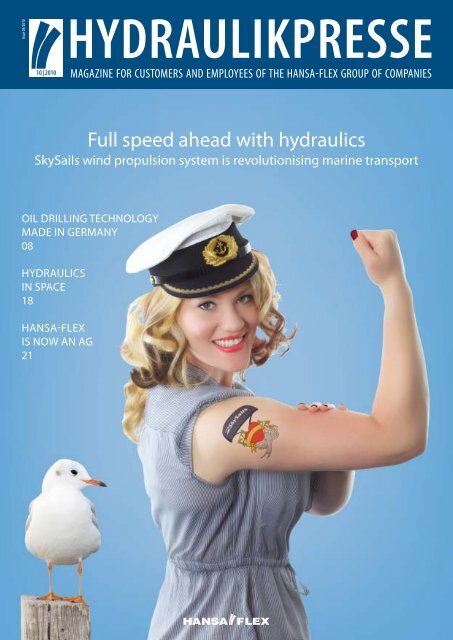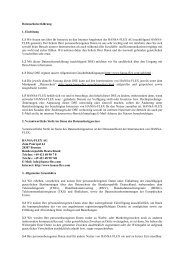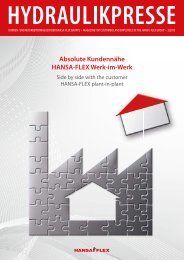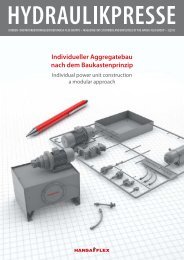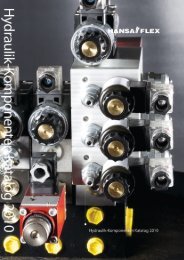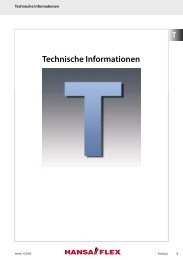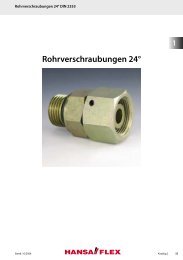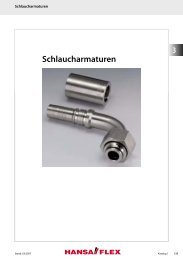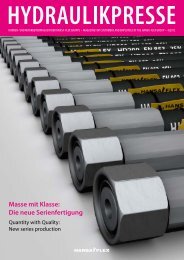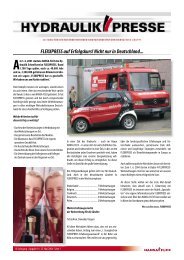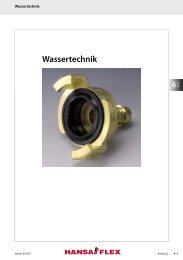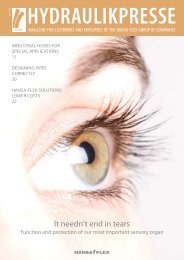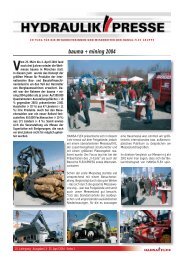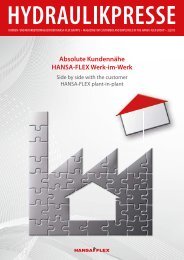HYDRAULIKPRESSE October 2010, english issue - Hansa Flex
HYDRAULIKPRESSE October 2010, english issue - Hansa Flex
HYDRAULIKPRESSE October 2010, english issue - Hansa Flex
Create successful ePaper yourself
Turn your PDF publications into a flip-book with our unique Google optimized e-Paper software.
Issue 05/<strong>2010</strong><br />
Hydraulikpresse<br />
Magazine for customers and employees of the HANSA-FLEX group of companies<br />
Full speed ahead with hydraulics<br />
SkySails wind propulsion system is revolutionising marine transport<br />
Oil drilling technology<br />
made in Germany<br />
08<br />
Hydraulics<br />
in space<br />
18<br />
HANSA-FLEX<br />
is now an AG<br />
21
CoNteNt hydraulikpresse 10|<strong>2010</strong><br />
CoVer story<br />
04 GoiNG WitH tHe WiNd<br />
international marine transport can cut costs with wind power<br />
skysails cut maritime fuel con-<br />
04<br />
sumption by as much as 50%<br />
oil drilling technology made in Germany<br />
ariane 5 launch relies on<br />
hydraulic technology<br />
08<br />
state-of-the-art paper<br />
10<br />
production in Brandenburg<br />
18<br />
HaNsa-FleX is now an<br />
21<br />
aktiengesellschaft<br />
photo: Julia ahlers photo: skysails gmbh & co. kg<br />
photo: Julia ahlers photo: esa<br />
photo: Julia ahlers<br />
trade Fairs & eVeNts<br />
06 sHips, MaCHiNes, MariNe teCHNoloGy<br />
sMM trade fair presence a complete success<br />
NeWs<br />
07 tHe atHletes’ NeW ClotHes<br />
hansa-fleX kitted out 30 clubs with new team uniforms<br />
20 liFeloNG learNiNG<br />
training as a hydraulics technician at the iha opens up many opportunities<br />
21 a step iNto tHe Future<br />
hansa-fleX hydraulik gmbh is now hansa-fleX ag<br />
praCtiCal<br />
08 a Modular Colossus<br />
offshore drilling rigs from the Bavarian woods<br />
10 aN eNdless sHeet<br />
Modern paper production in spremberg<br />
13 all set For HalloWeeN<br />
the cordes family meets the pumpkin<br />
16 true MasterWorks<br />
reinhold Meister – a proud tradition in water engineering<br />
Work & liFe<br />
12 BuCkle up For saFety<br />
seatbelts increase chances of survival enormously<br />
people at HaNsa-FleX<br />
14 dediCatioN aNd its reWards<br />
Maik Müller is german national deaf 1500 m champion<br />
15 sittiNG still is Not aN optioN<br />
nico röger plays wheelchair basketball at high level<br />
FasCiNatioN teCHNoloGy<br />
18 a Very loNG Way up<br />
ariane 5 is europe's flagship space exploration project<br />
did you kNoW...?<br />
22 tHe last reNaissaNCe MaN<br />
alexander von humboldt – a life devoted to research<br />
ruBriCs<br />
03 editorial | iMpressuM<br />
20 iHa traiNiNG seMiNar sCHedule<br />
22 NeWs tiCker<br />
23 CoMpetitioN | FaCts & FiGures | VaCaNCies | preVieW<br />
02<br />
hansa-fleX Customers magazine
iMpress editorial<br />
dear readers,<br />
the world’s oceans are the main arteries of international commerce. More than 90 percent of the<br />
world's production volume is moved over water. hansa-fleX has supplied certified hoses to the<br />
shipping industry for many years. last month, we exhibited our expertise in this sector at the sMM<br />
trade fair in hamburg.<br />
in our cover story, we take to the skies. With its towing kite propulsion system, the hamburg-based<br />
company skysails offers shipping operators an interesting option for reducing costs. to find out how<br />
a 160 square metre towing kite can help to cut maritime fuel consumption by as much as 50 percent,<br />
and how hydraulics is involved, turn to page 4.<br />
Water is also the key element in paper manufacturing. on page 10, you can read how a former coal<br />
refining plant known as “Black pump” has been converted into a modern industrial estate, how paper<br />
is made at the hamburger spremberg paper factory, and why hansa-fleX chose this particular<br />
site for a new shop.<br />
When it comes to water engineering, reinhold Meister gmbh is a leader in germany and throughout<br />
europe. starting on page 16, we explain how hansa-fleX ensures a constant supply of replacement<br />
parts far from any human settlement, and why gps coordinates are so important for the machine<br />
operators who work for reinhold Meister gmbh.<br />
editor / puBlisHer:<br />
HaNsa-FleX Hydraulik aG<br />
Zum panrepel 44 • 28307 Bremen, Germany<br />
telephone: 0421 - 4 89 07 - 0<br />
Fax: 0421 - 4 89 07 - 48<br />
e-Mail: info@hansa-flex.com<br />
www.hansa-flex.com<br />
it was by sea that alexander von humboldt arrived in south america. during his four-year research<br />
expedition, the last renaissance man survived countless adventures and made world-shaping<br />
discoveries. the life’s work of the man whose footprints seem to span the continent even now, are<br />
the subject of a hydraulikpresse report on page 22.<br />
We wish you much reading pleasure<br />
tHe MaNaGiNG Board<br />
Compilation: enrico kieschnick, dirk Brunne,<br />
Jan-Christoph Fritz, Julia ahlers<br />
articles: dirk Brunne, Jan-Christoph Fritz<br />
layout: Jan-Christoph Fritz<br />
print: Berlindruck · www.berlindruck.de<br />
responsible for content: Wolfgang rink<br />
Frequency: Bimonthly<br />
subscribe to the Hydraulikpresse on our website:<br />
www.hansa-flex.com/kommunikation/<br />
hydraulik presse/abo_service.html<br />
to cancel your subscription, please send an e-Mail to:<br />
ma@hansa-flex.com<br />
thomas armerding<br />
photo: Julia ahlers<br />
uwe Buschmann<br />
photo: Julia ahlers<br />
dieter H. seidler<br />
photo: Julia ahlers<br />
peFC/04-31-0976<br />
Note: this <strong>issue</strong> of Hydraulikpresse is also<br />
published in German. Further details are available<br />
from your branch.<br />
<strong>issue</strong> oCtoBer <strong>2010</strong><br />
16. year<br />
Cover page arrangement: Nadine Beneke<br />
photo: Julia ahlers<br />
HYDrauLiKPresse 10|<strong>2010</strong> 03
CoVer story skysails<br />
GoinG witH tHe winD<br />
international Marine transport can cut costs With Wind poWer<br />
Wind is cheaper than oil. there can be no argument about that. on the high seas, the wind is indisputably the cheapest, most environ-mentally<br />
friendly energy source. since conventional sail systems cannot possibly satisfy the demands of modern marine traffic, this potential<br />
is no longer used by shipping lines. the company skysails gmbh & co. kg in hamburg intends to change this. With their concept, fuel consumption<br />
can be reduced by as much as 50 percent. What was dismissed a few years ago as “eco-madness” is now an attractive alternative<br />
for shipping companies.<br />
Water covers over two thirds of our planet’s<br />
surface. so it is hardly surprising that the<br />
seas are by far the most important channels<br />
for goods movements, accounting for 98 percent<br />
of global trade. freighters transport everything<br />
from fruit to ores to cars by sea – and the effects<br />
on the environment are serious. a study conducted<br />
in 2003 by the university of newark calculated that<br />
the world’s merchant shipping fleets release as much<br />
nitrogen oxide into the atmosphere as the entire<br />
united states. large cargo vessels consume up to<br />
30,000 litres of fuel to travel 100 kilometres. But with<br />
the skysails towing kite, this could all soon change.<br />
as the market and technology leader in automated<br />
towing kite systems, the company develops, manufactures<br />
and markets an internationally patented<br />
wind propulsion system for cargo vessels based on<br />
the principle of large towing kites.<br />
tHe skysails systeM<br />
the skysails system consists of three simple main<br />
components: a towing kite with rope, a hydraulic<br />
launching and recovery system, and a control system<br />
for automatic operation. instead of traditional sails<br />
fitted to a mast, skysails uses large towing kites that<br />
look very like a paraglider. the towing kites use the<br />
strong, stable winds that blow at altitudes between<br />
100 and 300 metres to provide foward motion. By<br />
means of dynamic flight manoeuvres, e.g. in a “figure<br />
8” pattern, skysails generate five to 25 times more<br />
power per square metre of surface area than conventional<br />
sails. the enormous tractive forces are transmitted<br />
to the ship via a superstrong, tear-proof rope.<br />
the energy supply to the control pod is ensured by<br />
means of a patented special cable integrated in the<br />
towing rope.<br />
HydrauliC lauNCH aNd<br />
reCoVery systeM<br />
hydraulic technology is used for both launching<br />
and recovering the kite. the towing kite is<br />
lifted out of the compartment where it is folded<br />
for stowing by a telescopic mast. a unit produced<br />
by hansa-fleX aggregatebau service nord in<br />
photo: skysails gmbh & co. kg<br />
neumünster extends the telescopic mast to a height<br />
of 23 metres. at this height, the towing kite unfolds<br />
to its full size and can be launched. the rope is paid<br />
out by a winch until its operating altitude is reached.<br />
the recovery process is performed in the reverse order.<br />
the winch retracts the towing rope and the towing<br />
kite docks on the launch and recovery mast. the<br />
towing kite is then reefed and the telescopic mast retracts.<br />
the towing kite and the control pod can then<br />
be stowed in the kite storage compartment, which<br />
is no bigger than an old-fashioned telephone kiosk.<br />
Both procedures are largely automated and take between<br />
10 and 20 minutes.<br />
iNstallatioN of the hydraulic telescopic mast which is used to engage and release the kite at a height of 23 m<br />
photo: skysails gmbh & co. kg<br />
04<br />
hansa-fleX Customers magazine
skysails CoVer story<br />
“SkySails towing kites generate from 5 to 25 times more power<br />
per m2 of surface area than normal sails!”<br />
photo: skysails gmbh & co. kg<br />
teCHNiCal eXpertise FroM<br />
HaMBurG-WilHelMsBurG<br />
preliminary discussions between skysails and<br />
hansa-fleX, represented by regional manager<br />
Wilfried krampitz and raphael tourré from internal<br />
technical support at the hamburg-Wilhelmsburg<br />
branch, went well. skysails brought the technical<br />
expertise of hansa-fleX on board. one of our main<br />
advantages was our closely meshed branch network.<br />
for example, the experts of aggregatebau nord<br />
in neumünster designed, developed and built the<br />
hydraulic unit that would extend and retract the telescopic<br />
mast in close consultation with skysails. the<br />
branch in Wismar supplied the skysails production<br />
and test centre with replacement parts.<br />
one of the first shipping lines to fit the towing kites<br />
on its ships was Beluga shipping. at the moment,<br />
only a modest number of ships fly the skysails kites.<br />
But several more will soon be equipped with this innovative<br />
technology. Because: using skysails technology<br />
can help to save enormous quantities of fuel,<br />
and this in turn lowers the operating costs for shipping<br />
significantly. the low purchasing and operating<br />
costs of skysails means that the investment will pay<br />
for itself in as little as three to five years.<br />
History oF tHe CoMpaNy<br />
photo: skysails gmbh & co. kg<br />
a similar qualification in shipbuilding and offshore<br />
technology. the company is headquartered in hamburg-harburg.<br />
in addition, skysails has a production<br />
and test centre in the hanseatic city of Wismar as<br />
well as a joint branch office with the highly respected<br />
marine engine supplier zeppelin power systems for<br />
worldwide sales and service of skysails propulsion in<br />
hamburg-Bahrenfeld. the company has 80 permanent<br />
employees, mainly engineers. there are also a<br />
number of independent associates and a large network<br />
of well-known partners that support development<br />
work. currently, skysails is offering towing kite<br />
propulsion systems for cargo vessels with an effective<br />
photo: skysails gmbh & co. kg<br />
load of between 8 and 16 tons. skysails with an effective<br />
load of 32 tons are in development. it is planned<br />
to extend the product programme to systems with an<br />
effective load of up to 130 tons. an effective tractive<br />
force of 8 tons by a skysail corresponds to approx.<br />
600 to 1,000 kW installed main engine power on<br />
average - depending on the ship‘s properties such as<br />
propeller efficiency degree or resistance.<br />
But it seems highly likely that the winds are set fair<br />
for future success of the company. after all, wind will<br />
always be cheaper than oil. and for on-board hydraulics,<br />
hansa-fleX will always be at its station.<br />
skysails was established in hamburg in 2001 by<br />
stephan Wrage, who has an advanced degree in<br />
industrial engineering, and thomas Meyer, who has<br />
tHe toWiNG kite uses the strong, stable winds at altitudes between 100 and 300 m to generate forward motion.<br />
HYDrauLiKPresse 10|<strong>2010</strong> 05
trade Fairs & eVeNts hansa-fleX at the sMM<br />
sHiPs, MacHines,<br />
Marine tecHnoLoGY<br />
trade fair presence a coMplete success<br />
Fluid serViCe was the main attraction for our visitors.<br />
this year for the fourth time, hansa-fleX took<br />
part in the sMM, the leading trade fair for<br />
representatives of the shipbuilding industry in<br />
hamburg. from 7-10 september, we presented our<br />
products, services and solutions to the interested<br />
technical community. this year, hansa-fleX in fact<br />
had two stands. hansa-fleX fluid service welcomed<br />
members of its own technical community in front of<br />
the trade fair building. a service that offers advantages<br />
to all businesses in the maritime sector. for<br />
example, fluid service is able to analyse oil samples<br />
photo: Julia ahlers<br />
from hydraulic systems in the vessel directly on site<br />
and test important parameters such as the oil’s purity,<br />
viscosity or water content. if necessary, immediate<br />
steps can be taken to prevent systems from failing<br />
due to contaminated oil. from oil filtering with a parallel<br />
flow filter system to a complete oil change – our<br />
experts in the fluid service were ready with advice<br />
and help. With more than 50,000 visitors and over<br />
2,000 exhibitors, sMM <strong>2010</strong> in hamburg was once<br />
again a resounding success. this was evident not only<br />
at the hansa-fleX stand outside the building, but<br />
also in hall a1. several aspects of the hansa-fleX<br />
offering were exhibited here, including the special<br />
segment for metal and ptfe hoses. and naturally the<br />
segment for offshore and industrial hoses was well<br />
represented at the trade fair. coolant water, air and<br />
chemicals are transported just as reliably as fuels or<br />
lubricants through offshore industrial hoses. the hoses<br />
are resistant to seawater, vibrations, temperature<br />
fluctuations, ozone, and abrasive media.<br />
hansa-fleX cooperates with all of the most respected<br />
classification bodies in the business, so we<br />
can ensure compliance with the various requirements<br />
in many countries. for example, based on<br />
its exemplary quality management system, the<br />
hamburg-stellingen branch passed its last audit by<br />
germanischer lloyd with no non-compliances, thereby<br />
retaining its status as a self-inspection facility<br />
without restriction. We conduct regular audits or our<br />
upstream suppliers as well, as a further guarantee of<br />
impeccable quality. Working from this high standard,<br />
the hansa-fleX hamburg-stellingen branch supplies<br />
many elements of the german armed forces,<br />
including the german navy. We are also an original<br />
equipment supplier to many well-known german<br />
shipyards. over time, we have become an experienced,<br />
reliable system partner even for unusual assignments<br />
such as arise when building luxury yachts<br />
and submarines.<br />
the hansa-fleX stands were extremely well attended<br />
for the entire period of the fair. as a result,<br />
new contacts were made, and existing ones were<br />
strengthened. so of one thing there can be no doubt:<br />
we’ll be there again in 2012.<br />
06<br />
hansa-fleX Customers magazine<br />
photo: Julia ahlers
cluB sponsorship NeWs<br />
photo: Julia ahlers<br />
tHe atHLetes’ new cLotHes<br />
hansa-fleX kitted out 30 cluBs With neW teaM uniforMs<br />
it is still a little chilly when the team trots out onto<br />
the field for training. the first, light mist of autumn<br />
still hangs over the training ground as the players<br />
begin their warm-up exercises. today’s training<br />
session will be especially hard, because they have<br />
an important match against a strong opponent this<br />
weekend. But something is different: the bright,<br />
fresh colours of the team's strip contrast vividly with<br />
the grey of the autumn morning – because they are<br />
brand new.<br />
the same thing has happened<br />
for many other<br />
teams from a total of 30<br />
clubs, which were selected<br />
in this year’s club<br />
sponsoring campaign by<br />
hansa-fleX ag. each received<br />
team uniforms with<br />
a value of as much as 1,000<br />
euro.<br />
“The clubs were extremely<br />
grateful for this assistance, as it is<br />
becoming more and more difficult in<br />
these times to find sponsors!”<br />
the high-quality strips have been produced by outfitters<br />
team sport & fashion in cooperation with<br />
hansa-fleX. this is now the third edition of our<br />
highly successful club sponsoring campaign. the<br />
quality provided by this manufacturer is indisputable,<br />
and because of the good value-for-money ratio,<br />
some of the teams were even able to buy strip for up<br />
to two full teams. the clubs were able to choose from<br />
a wide variety of colour combinations – of course the<br />
players’ names and numbers appeared boldly on the<br />
back of the shirts.<br />
the clubs were extremely grateful for this assistance,<br />
as it is becoming more and more difficult in these<br />
times to find sponsors that<br />
are prepared to support<br />
non-professional clubs,<br />
out of the glare of national<br />
publicity. We hope that<br />
these teams will approach<br />
their upcoming games<br />
with even greater enthusiasm<br />
and commitment.<br />
at the same time, all of the<br />
clubs that were unfortunately<br />
unsuccessful in this<br />
year's drawing should not give up hope. We expect<br />
to have another sponsoring campaign for 2011 next<br />
year. of course we will announce it in good time.<br />
photo: norbert ott<br />
photo: Michael heinke<br />
deliGHted WitH tHeir NeW teaM sHirts the winners<br />
in our club sponsoring campaign represent a wide variety of<br />
sporting activities.<br />
HYDrauLiKPresse 10|<strong>2010</strong><br />
07
praCtiCal oil drilling technology<br />
a MoDULar coLossUs<br />
offshore drilling rigs froM the Bavarian Woods<br />
there are not many companies in germany that can boast a history stretching back over a century.<br />
But Max streicher gmbh & co. kg aa in deggendorf, Bavaria, is one that can. established as a<br />
building company in 1909, the streicher group is now built on four thriving business lines. one is<br />
pipeline and plant construction. for many years, hansa-fleX field service technician Josef pertler<br />
has been their first call for all of their hydraulic connector equipment.<br />
08 hansa-fleX Customers magazine<br />
photo: Julia ahlers
oil drilling technology praCtiCal<br />
Most of us played with building bricks when<br />
we were children. We piled one little cube<br />
on top of the other, and really the result was<br />
always a tower. very occasionally a house. Most definitely<br />
never an offshore deep drilling plant. But Max<br />
streicher gmbh & co. kg aa works a little differently.<br />
What the engineers from deggendorf have created<br />
looks rather like squaring the circle. Because with<br />
the development and construction of the vdd 400.1<br />
streicher has paved the way for completely new possibilities<br />
in offshore drilling operations.<br />
the masterstroke: vdd 400.1 is designed in modules,<br />
so it can be erected and dismantled in the shortest<br />
time imaginable. Most of the modules consist of an<br />
iso container, which must not weigh more than eleven<br />
tons. this was a particular challenge for the boffins<br />
at streicher, because many of the machines that are<br />
used in the system weigh over 30 tons on their own.<br />
the advantage of modular engineering is that the<br />
system can be adapted to practically any space constraints.<br />
since the individual modules are relatively<br />
light, they can easily be loaded onto a drilling platform<br />
from a ship. When drilling is complete, the system<br />
can be dismantled within ten days and transported<br />
to a new drilling site. the time-hounoured practice<br />
of leaving old, played out rigs to rust in place will soon<br />
be a thing of the past. this is beneficial for the environment,<br />
and the customer saves money, because the<br />
drilling system can be used again and again.<br />
autoMatiC operatioN<br />
vdd 400.1 operates almost entirely automatically.<br />
Just eight technicians per shift are needed to keep<br />
it running smoothly. for this, they rely on many hydraulic<br />
systems: the automatic pipe handling system<br />
for example. the drill head on the seabed is connected<br />
to the rig via the “drill string”. as the drill head<br />
carves its way deeper and deeper into the undersea<br />
bedrock, up on the rig more pipes are added behind<br />
it and connected to each other. an operation that<br />
was previously accomplished by sheer brawn and<br />
involved significant risk is managed by a fully automatic<br />
system in the vdd 400.1. giant, computer-controlled<br />
arms grasp the long rods and move them up<br />
against the last pipe. there, they are welded together<br />
in another automated operation.<br />
a lot oF poWer For<br />
a little WeiGHt<br />
the vdd 400.1’s technical specifications are impressive.<br />
Weighing in at just under 1,000 tons, it is a<br />
feather compared with other drilling systems. But<br />
the hydraulic top drive has a hook load of 400 tons.<br />
Maximum torque: 85,000 newton metres. Maximum<br />
drilling depth: 5,000 metres. of course, it stands to<br />
reason that with these figures the hydraulic systems<br />
are a little larger. the hydraulic hoses that carry the<br />
pressure medium for the drilling system are clearly<br />
visible from a great distance. in all there are 16 hoses,<br />
each as thick as a man's thigh. each is 16 metres long<br />
and is connected to the drilling system.<br />
in the machine room of this colossus, unions supplied<br />
by hansa-fleX are everywhere. “We have enjoyed<br />
a trusting working relationship with streicher for<br />
almost a decade. today, streicher relies on the expertise<br />
of hansa-fleX in many projects”, says field<br />
technician Josef pertler. and streicher is at work on<br />
an enormous number of projects. the company’s<br />
civil and structural engineering sector is engaged<br />
in building roads, conduit systems and industrial<br />
engineering projects all over europe. if rapid support<br />
is ever needed at one these sites, fleXXpress is<br />
on hand anywhere on the continent. the company’s<br />
mechanical engineering sector, which also builds<br />
fairground rides, uses practically every product<br />
hansa-fleX makes. even our cylinder repair facility<br />
in königshofen has been called upon to repair the occasional<br />
hydraulic cylinder for streicher.<br />
HiGHest saFety staNdards<br />
recent events have shown that it is high time for the<br />
existing safety concepts in deep sea drilling to be<br />
thoroughly reviewed and reconsidered. the highest<br />
standards of safety are embedded in the streicher<br />
corporate philosophy. the first offshore drilling system<br />
produced by streicher was designed and built for<br />
an order from the norwegian company seawell ltd..<br />
on June 9, streicher unveiled this system to selected<br />
industry representatives. “the norwegian government’s<br />
safety regulations are extremely stringent.<br />
the vdd 400.1 conforms to the norsok standard,<br />
which is among the most demanding specifications<br />
anywhere in the world”, declares dipl.-ing. hanserich<br />
endler, an engineer with streicher.<br />
here is one example: the “blowout preventer” – an<br />
enormous block that can weigh more than 100 tons<br />
– is positioned directly above the drill hole in the<br />
seabed to ensure constant control. if critical volume<br />
fluctuations are measured in the drilling fluid inside<br />
the drill hole, extraction is interrupted by four safety<br />
valves. each of these valves is strong enough to plug<br />
the line on its own. in the unlikely event that all four<br />
valves fail, a a fifth valve severs the line and seals it.<br />
that is just one of many safety systems in this modular<br />
colossus. “We have a responsibility to our environment.<br />
We are deeply aware of that in the streicher<br />
group. accordingly, safety has the very highest priority<br />
in our systems”, declares Mr. endler.<br />
independence from fossil fuels is undoubtedly a<br />
noble objective. But we have a long way to go before<br />
we realise this objective. all the signs indicate that<br />
Mankind will still be reliant on oil wells and extraction<br />
systems for a long time to come. it is good to<br />
know that streicher systems satisfy the highest possible<br />
safety standards.<br />
photo: Julia ahlers<br />
photo: Julia ahlers<br />
photo: Julia ahlers<br />
eNorMous HydrauliC systeMs drive the Vdd 400.1 offshore deep drilling plant – the drill head can drill into the seabed down to a depth of 5,000 m, fully automatically.<br />
HYDrauLiKPresse 10|<strong>2010</strong><br />
09
praCtiCal paper production<br />
an enDLess sHeet<br />
Modern paper production in spreMBerg<br />
it is one of the most commonly used materials in the world – you are holding it in your<br />
hand now. exactly. We are talking about paper. Whether it is the daily newspaper, paper<br />
handkerchiefs, wallpaper, packaging or books – scarcely a day goes by when you don’t<br />
touch paper. and the production process for paper has remained basically unchanged for<br />
1000 years. only the equipment has improved somewhat. one of the most modern paper<br />
machines in europe is located in spremberg, Brandenburg. hansa-fleX was there at its<br />
construction, as a service partner for hydraulic connecting equipment.<br />
for years, the heart of the niederlausitz region<br />
was dominated and defined by coal and electricity.<br />
even today, it is common to hear the traditional<br />
miners’ greeting “glück auf”, and the football<br />
team is called “energie”. the area is spremberg, the<br />
schwarze pumpe (Black pump) district. lying between<br />
cottbus and dresden, this was once a centre<br />
for refining brown coal (lignite). today, the site has<br />
been turned into an industrial estate that is home to<br />
82 companies. the “hamburger spremberg” paper<br />
factory stands right in the middle. and at the beginning<br />
of July, hansa-fleX opened its new shop,<br />
“schwarze pumpe”, very close to here.<br />
HelpiNG WitH eCoNoMiC CHaNGe<br />
“The machine has a capacity of<br />
330,000 t per year – the paper is<br />
made entirely from recycled paper!”<br />
in october, 2003, when ground was broken for the<br />
new paper factory in the schwarze pumpe industrial<br />
estate, hamburger spremberg<br />
gmbh & co. kg made<br />
a significant contribution<br />
to altering the economic<br />
fabric of the region. one<br />
of the aims was to employ<br />
local technicians to begin<br />
operations in the new<br />
factory. to this end, during the almost 20 months it<br />
took to build the factory, 25 workers from completely<br />
unrelated industries were trained to make paper. the<br />
project was highly successful. today, 375 employees<br />
have found new employment with the paper factory.<br />
the same number again in the surrounding district.<br />
paper has been manufactured in spremberg with the<br />
very latest technology since the beginning of april<br />
2005. for example, in ideal conditions the paper machine<br />
can process 330,000 tons of raw paper to produce<br />
corrugated cardboard. Because: in spremberg,<br />
they don’t make simple white paper like the sheets<br />
we put in our copiers. here beside the spree, they<br />
make white containerboard. it consists of three plies,<br />
and is produced entirely from recycled paper. this in<br />
turn is used to make cardboard boxes and packaging.<br />
FroM reCyCled paper<br />
to paCkaGiNG<br />
the recycled paper is inspected and sorted according<br />
to its composition as soon as it is delivered. for<br />
the white cover layer for the “spreeWhite” paper<br />
type, only white recycled paper can be used. about<br />
20,000 tons of raw material are warehoused at the<br />
factory, ready for processing. this is enough for eight<br />
to ten days’ production. in material preparation the<br />
recycled paper is dissolved<br />
in large amounts of water.<br />
the paper slurry is then<br />
passed through many machines<br />
with perforated and<br />
slotted sieves until almost<br />
all impurities have been<br />
removed. after the material<br />
has been prepared, additives such as starch are<br />
introduced to give the paper the desired properties.<br />
tHe paper MaCHiNe<br />
the halls that house the paper machine have two<br />
things in common: they are hot and noisy. everywhere<br />
in the 100-metre long building, machinery<br />
parts are in motion, creating a paper web 1,000<br />
10 hansa-fleX Customers magazine
paper production praCtiCal<br />
metres long by 5.4 metres wide. enough paper every<br />
minute to cover a football pitch. But before the finished<br />
paper can be rolled up, it must pass through<br />
three main sections. first, the fibre pulp coming<br />
from the material preparation department is heavily<br />
diluted with water. this suspension contains<br />
only seven percent of fibre materials per litre and is<br />
sprayed evenly onto a rotating sieve. as the water<br />
drains away or is suctioned out, the fibres are deposited<br />
on the sieve, forming a fibre web. after this<br />
step, called the sheetforming process by papermakers,<br />
paper web still contains about 80% water. the<br />
paper machine at hamburger spremberg has three<br />
sheetforming units like this, and their fibre webs are<br />
merged to form a single strip of paper before being<br />
forwarded to the next processing step.<br />
”While the paper machine was being<br />
built, HANSA-FLEX was on hand<br />
at all times as service partner!”<br />
next, this paper strip is passed through rollers to<br />
squeeze more water out. the rollers are pressed<br />
together so hard that the dry content in the paper<br />
emerging at the other end has risen to 52 percent.<br />
this pressing process also increases the mechanical<br />
strength of the paper. then, heat is applied to dry it<br />
further. for this, the paper runs in a slalom through<br />
steam-heated drying cylinders. With its smoothing<br />
unit at the end of the drying section, the machine<br />
creates a smooth surface and consistent sheet thickness.<br />
the paper is then subjected to a thorough quality<br />
control inspection. if it passes this inspection, it<br />
is rolled up on steel reels and sent to intermediate<br />
storage to await shipment.<br />
alWays Close at HaNd<br />
While the paper machine was being built,<br />
hansa-fleX was on hand at all times as service<br />
partner for the sophisticated hydraulic systems<br />
and to maintain the construction machinery. the<br />
fleXXpress rapid hydraulic service was also on constant<br />
alert to support the standard spare parts delivery<br />
service. With its new “schwarze pumpe” shop,<br />
hansa-fleX has now established a presence very<br />
close by, so it can be on the scene even more quickly.<br />
Because closeness has its benefits. not only the hamburger<br />
spremberg paper factory, but for all the other<br />
companies on the industrial estate, and for over<br />
350,000 hansa-fleX customers all over the world.<br />
photo: Julia ahlers photo: Julia ahlers photo: Julia ahlers photo: Julia ahlers photo: Julia ahlers<br />
paper produCtioN is a complicated process involving<br />
many complex machines.<br />
HYDrauLiKPresse 10|<strong>2010</strong><br />
11<br />
Background photo: Julia ahlers
Work & liFe the seatBelt<br />
BUcKLe UP For saFetY<br />
seatBelts increase chances of survival enorMously<br />
it was a frenchman, gustave-désiré leveau, who<br />
first applied for a patent for a four-point seatbelt.<br />
that was in 1903. louis renault followed his example<br />
the same year and obtained a patent for the fivepoint<br />
seatbelt, and it was from this prototype that<br />
volvo developed the three-point belt that is in most<br />
common use today. starting in 1959, seatbelts were<br />
standard equipment in all saab and volvo vehicles.<br />
When the german federal government made it mandatory<br />
to wear seatbelts – although no penalties<br />
were imposed for disobedience – the law met with<br />
intense opposition from some drivers. it was another<br />
eight years before failure to wear a seatbelt became<br />
punishable with a fine of 40 dM. compliance then<br />
rose immediately from 60 to 90%. and yet, seatbelts<br />
are the single most important safety mechanism in<br />
the interior of the vehicle, as is attested by the dramatic<br />
decline in fatalities immediately after wearing<br />
seatbelts became mandatory. By wearing their seatbelts,<br />
car drivers increase their chances of surviving<br />
an accident by 45%. statistics show that almost 50%<br />
of those who die in traffic accidents were not wearing<br />
a seatbelt. 8% were driving cars that were not<br />
fitted with them, or were exempt from wearing one,<br />
in a further 16% of cases, it was no longer possible<br />
to determine whether they were wearing one or not.<br />
only 35% of people who were killed in car accidents<br />
were properly belted. as a rule: everyone must wear<br />
a seatbelt. But it is the exceptions that prove the rule.<br />
When driving at walking pace, reversing, and driving<br />
from one house to the house next door, drivers in<br />
germany are not obliged to wear a seatbelt.<br />
saFety First<br />
But anyone who is driving in normal traffic on the road<br />
without wearing a seatbelt is liable to receive a fine of<br />
30 euros. people who make their child wear a seatbelt<br />
but do not use a child safety seat will also have to pay<br />
30 euros. if the violation concerns several children, the<br />
fine is 35 euros. in flensburg, drivers who are irresponsible<br />
enough not to secure their children in any way,<br />
receive a fine of at least 40 euros and one point on<br />
their driving licence. generally, the driver is responsible<br />
for ensuring that his passengers are safely buckled<br />
in. it is also the driver who is penalised if his passengers<br />
do not comply. in germany, men are found not<br />
wearing seatbelts noticeably more often than women,<br />
and older people seem to place greater value on<br />
safety than younger people. those who believe that<br />
the kinetic energy produced when driving slowly can<br />
be absorbed by the arms should take note: at speeds<br />
photo: Julia ahlers<br />
photo: Julia ahlers<br />
barely above walking pace, this is not possible without<br />
injury. and open fractures of the elbows are not<br />
pretty, they are excruciatingly painful, and they take<br />
a long time to heal. furthermore, the compensation<br />
that might be payable by an insurance company in the<br />
event of an accident can be significantly reduced if the<br />
insured person is not wearing a seatbelt. for all these<br />
reasons: Buckle up, and drive carefully.<br />
aCCordiNG to statistiCs, the seatbelt increases drivers’<br />
chances of surviving a traffic accident by 45%.<br />
12 hansa-fleX Customers magazine
hydraulics in farMing praCtiCal<br />
aLL set For HaLLoween<br />
the cordes faMily Meets the puMpkin<br />
photo: Julia ahlers<br />
no one can claim that halloween is an essentially<br />
german festival. But in recent years, the night<br />
of horrors has enjoyed increasing popularity,<br />
particularly with children. and carved pumpkins are<br />
becoming more and more common as garden decorations<br />
at this time of year. at the cordes pumpkin<br />
patch in kirchlinteln, this is very gratifying. astrid<br />
cordes wanted to decorate her farmyard with pumpkins<br />
back in 2003. But this was no easy ambition. “We<br />
had to drive a long way before we found anyone who<br />
sold them. and then, pumpkins were very expensive”,<br />
recalls the farmer now. astrid cordes decided she<br />
would not put up with this, so a year later she began<br />
growing her own pumpkins. starting with 18 different<br />
types, she sold her wares from small self-service<br />
stalls by the roadside. these days, the cordes family<br />
grows over 10,000 pumpkins a year. they offer more<br />
than 120 different kinds for sale. every pumpkin is<br />
harvested by hand.<br />
she offers simple recipes for preparing pumpkins in<br />
a wide variety of ways. from baby food to pumpkin<br />
bread, the book covers it all. the cordes family now<br />
sell their wares in their own farmhouse shop and at<br />
three self-service stalls in the region. Besides pumpkin<br />
jam, pumpkin liqueur, and pumpkins in the most<br />
startling colours, you will also find small decorative<br />
items or pumpkin juice.<br />
puMpkiN aCtiVity days<br />
since pumpkins and halloween go together like<br />
night and darkness, the cordes family has instituted<br />
a great halloween programme for children aged 6 to<br />
14. then, the children can carve the pumpkins they<br />
themselves have picked in the field. and the pumpkin<br />
festival is celebrated in mid-september every<br />
year, under the pumpkin pyramid in the pumpkin<br />
patch.<br />
photo: Julia ahlers<br />
tend 200 beef and 80 dairy cattle at the farm in kirchlinteln.<br />
and when the hydraulic hoses on his farming<br />
machinery need to be replaced, dirk cordes drives to<br />
his nearest hansa-fleX branch. the replacement is<br />
handed over promptly. if he has to go in october, perhaps<br />
he will bring a pumpkin. find out more about<br />
the cordes family's produce at www.kuerbis-undmehr.de.<br />
reFereNCe Work<br />
over the last six years, astrid cordes has learned so<br />
much about pumpkins and their uses that she has<br />
compiled her knowledge in a cookery book entitled<br />
“alles kürbis oder was?”. in this 138-page volume,<br />
HydrauliCs at Work<br />
But the cordes family also runs a “normal” farm both<br />
outside and during the pumpkin season. on their<br />
70-hectare smallholding, they grow mainly fodder<br />
maize for their own beef and dairy herd. in all, they<br />
tHe Cordes FaMily still FarMs in the traditional way<br />
besides their pumpkin crop.<br />
HYDrauLiKPresse 10|<strong>2010</strong><br />
13
People at HANSA-FLEX Maik Müller<br />
Dedication and its rewards<br />
Maik Müller is German national deaf 1500 m champion<br />
HANSA-FLEX employee Maik Müller won the 1500 m race and came second in the 5000 m at the German National Athletics Championships<br />
for the Deaf. In this interview, the 23-year-old talks about his triumph, his work at HANSA-FLEX, and his next sporting objectives.<br />
Mr. Müller, a few weeks ago, you won the 1500<br />
metres at the German Deaf Athletics Championship.<br />
Warmest congratulations, first of all! How<br />
did you feel on crossing the finish line first?<br />
I was absolutely exhausted, but I was jubilant as well.<br />
Was your victory a surprise or did you start the<br />
race as a favourite?<br />
To be quite honest, I would never have thought I<br />
might be able to win it. So this victory was a tremendous<br />
surprise. For me and all of my supporters. But I<br />
also trained very hard for this race.<br />
How long have you been in competitive running,<br />
and how did you get into it?<br />
I’ve played sports ever since my schooldays. I started<br />
with football. I played regularly until November<br />
2008. Then between December 2008 and mid-2009<br />
I competed in triathlons. I only began training for<br />
running in June <strong>2010</strong>. That was another reason this<br />
win at the German National Championships was so<br />
surprising.<br />
You work for HANSA-FLEX in Weixdorf. What is<br />
your job there, exactly?<br />
In Weixdorf, I work in internal technical support.<br />
Is it true that all deaf people can lipread, or is that<br />
a fairy story?<br />
If deaf people have a cochlear implant (Editor’s note:<br />
A cochlear implant is a hearing prosthesiis for deaf<br />
people whose auditory nerve still works) or wear a<br />
hearing aid, they understand their surroundings<br />
better, and they can also lipread better. Other deaf<br />
people do not have a cochlear implant or hearing aid,<br />
and they then use sign language. I have learned to<br />
hear with a cochlear implant and to lipread. I can also<br />
understand and talk in sign language.<br />
How do you and your colleagues communicate?<br />
Unfortunately, there are very few hearing people<br />
who have also mastered sign language.<br />
I communicate by speaking. Many of my colleagues<br />
make an effort when they are talking to me. It helps<br />
if they speak simply and clearly.<br />
Can you explain briefly how sign language works?<br />
Is there a sign for each word, or do you use signs<br />
to create letters or syllables?<br />
Sign language consists of letters, gestures, and words.<br />
There are signs that one shows for different words.<br />
Every individual has different experiences with sign<br />
language. There are many differences depending on<br />
the country and national spoken lang-uage. So sign<br />
language is by no means uniform internationally.<br />
Are you comfortable as an employee with<br />
HANSA-FLEX?<br />
I am very comfortable at HANSA-FLEX. My colleagues<br />
are very nice and I enjoy the work very much.<br />
What else would you like to achieve in sports?<br />
Of course my target is to take part in the big championships<br />
in the next few years. That would be the<br />
European Championships for the Deaf in Turkey in<br />
2011, the 2012 World Championships in Canada, and<br />
the Deaflympics – that is the Olympic Games for the<br />
deaf in Athens in 2013. A purely personal goal for me<br />
is to run 5,000 metres in under 15 minutes 50.<br />
“I would never have thought I might be able to win it.<br />
So this victory was a tremendous surprise!”<br />
Photo: Martina Müller<br />
14 HANSA-FLEX Customers magazine
nico rÖger people at HaNsa-FleX<br />
sittinG stiLL is not an oPtion<br />
nico rÖger plays Wheelchair BasketBall at high level<br />
for nico röger, sport has always been an important part of his life. he played football as a child. he was so succeessful that he was invited to try<br />
out for the Werder Bremen youth team. But his life took a different turn. in the mid-1990s, doctors diagnosed bone cancer in his thigh.<br />
amputation was the only solution.<br />
now aged 26, one day when he was ten, he was<br />
celebrating his football club’s championship<br />
win. the next morning, he complained of a pain<br />
in his thigh. after several examinations, he received<br />
the devastating diagnosis: bone cancer. a course of<br />
chemotherapy followed, and finally his entire leg was<br />
amputated. there was no question of playing sports<br />
any more. “it was a difficult time for the whole family”,<br />
says nico röger today, “but as soon as i felt better,<br />
i started playing football again. on crutches, because<br />
in the early days i couldn’t get on with an artificial leg<br />
at all”. today when nico walks, you would not notice<br />
that he has an artificial leg.<br />
photo: Julia ahlers<br />
CoMplete NorMal, But diFFereNt<br />
after trying out several different sports, the<br />
hansa-fleX commercial clerk discovered wheelchair<br />
basketball. this sport pits men and women, with<br />
and without disabilities, against each other on equal<br />
terms. the dimensions of the court and the height<br />
of the nets are exactly the same as for “pedestrian”<br />
basketball. as as the name suggest, the athletes use<br />
specially designed sports wheelchairs to get around<br />
the court. however, the biggest difference is the classification<br />
of individual players. players are classified<br />
on a points system from 1 to 4.5 depending on their<br />
motor skills. a severely disabled player receives 1<br />
point, a wheelchair basketball player without a disability<br />
receives 4.5 points. the combined points for<br />
the five players on the court must not exceed 14.5.<br />
lookiNG up<br />
nico röger has been playing wheelchair basketball in<br />
achim for about 7 years. for a while, he played in two<br />
clubs. Because he was so good, he was given a double<br />
licence for young players, and was allowed to play<br />
for the team from lüneburg in a higher division, and<br />
so began playing in the 2nd division of the german<br />
national Wheelchair Basketball league (rBBl). “certainly<br />
i am ambitious about improving constantly.<br />
eventually, there came a time when it was not going<br />
to happen any more, so i started playing in lüneburg<br />
as well”, says the blond 26-year-old. But playing<br />
in two teams was extremely time-consuming. “My<br />
girlfriend has always supported me, but she wasn’t<br />
terribly happy that i had training at least three or four<br />
times a week, and weekends were practically always<br />
game days”, he says with a smile. these days, he plays<br />
only for Bsv achim. he also trains there three times<br />
a week, but the long drives to lüneburg have been<br />
dispensed with. “We want to build something here,<br />
and climb as far up the standings as possible”, says<br />
nico röger. promotion to the regional league came<br />
in 2009. the following year, the team were runners<br />
up to the league champions. they are hoping that<br />
2011 will see them promoted to the 2nd national<br />
league. perhaps they will soon set their sights on the<br />
national senior league.<br />
photo: Julia ahlers<br />
photo: Julia ahlers<br />
photo: Julia ahlers<br />
NiCo rÖGer during a wheelchair basketball game with BsV achim – the stated goal for the team is to win promotion to the 2nd National league in 2011. Good luck!<br />
HYDrauLiKPresse 10|<strong>2010</strong><br />
15
praCtiCal Water engineering<br />
trUe MasterworKs<br />
reinhold Meister – a proud tradition in Water engineering<br />
the company reinhold Meister gmbh is held to<br />
be one of the largest earthmoving companies<br />
in germany. and water engineering is traditionally<br />
one of the company’s primary activities. having<br />
started in standard river engineering, Meister consistently<br />
takes on new challenges in water engineering.<br />
With the hansa-fleX hydraulics workshop, they<br />
know they can always be sure of rapid spare parts delivery<br />
– even when they are working well away from<br />
populated areas. if you drive past the headquarters<br />
tHe NeW BaNk is seCured with matting layers and a<br />
covering layer of stones.<br />
photo: Julia ahlers<br />
of reinhold Meister gmbh in deggendorf, upper Bavaria,<br />
you get the merest glimpse of the size of this<br />
company's vehicle fleet. the excavators stand in serried<br />
ranks that seem to stretch to the horizon. the total<br />
fleet includes more than 700 machines. of these,<br />
150 are hydraulic tracked vehicles and self-propelled<br />
excavators. Malfunctions are repaired by Meister directly<br />
in the company’s own workshop. “some of the<br />
equipment we use cannot even be bought. We build<br />
them ourselves in that case”, explains workshop supervisor<br />
thomas Berndl. for example, an excavator<br />
bucket has been extended by a few metres to extend<br />
its operating range. since the hydraulic hoses were<br />
then too short, replacements were obtained through<br />
hansa-fleX field service technician Josef pertler.<br />
Fast WitH X-Code<br />
With such a huge number of vehicles, countless hose<br />
lines are needed. to make it as easy as possible to obtain<br />
spare parts, Meister has been using X-code for<br />
years. “X-code is really good”, says thomas Berndl. “it<br />
means we don’t have to spend a lot of time measuring<br />
the lines. We just quote the code over the telephone,<br />
and in the next delivery we receive the right<br />
hose lines”. stephan Margetan visits reinhold Meister<br />
gmbh almost every day. “the need for hose lines and<br />
other hydraulic components is really enormous. But<br />
given the number of projects they are working on,<br />
this is not surprising. Besides, we’ve worked with<br />
them for many years now. there is a great deal of<br />
trust on both sides”, states the field technician. the<br />
outsider can see straight away that the business relationship<br />
between reinhold Meister and hansa-fleX<br />
is better than just good. almost every employee in<br />
the workshop greets stephan Margetan by his first<br />
name. that may be due to the friendly nature of Bavarians<br />
in part, but it is surely due in equal part to the<br />
good cooperation between the companies.<br />
proJeCts tHrouGHout europe<br />
the range of projects Meister undertakes is every<br />
bit as varied as its vehicle fleet is large. if you pass<br />
a construction project involving water anywhere in<br />
europe, you will almost always see the logo of the<br />
experts from deggendorf emblazoned on the vehicles.<br />
this applies for the drakenburg canal on the<br />
Weser and at the danube delta in rumania, where<br />
Meister is restoring the banks of the sulina canal. for<br />
canal projects, Meister deploys a small army of machines.<br />
eight big excavators, each weighing over 70<br />
tons, two smaller ones, weighing up to 70 tons, four<br />
loaders and two crawler-loaders were floated by ship<br />
down the danube to the worksite. since the worksite<br />
is well away from transport routes and any other<br />
infrastructure, all spare parts must also be delivered<br />
by ship. this takes time, which as everyone knows, is<br />
money. especially when a construction machine is<br />
immobilised.<br />
16 hansa-fleX Customers magazine
Water engineering praCtiCal<br />
“The range of projects that Meister undertakes is<br />
as varied as its vehicle fleet is large”<br />
photo: Julia ahlers<br />
iMMediate replaCeMeNt oN site<br />
in order to ensure that hose lines can be replaced<br />
as rapidly as possible in urgent cases, hansa-fleX<br />
has provided a hydraulics workshop on the danube<br />
delta. this workshop is equipped with all of the<br />
spare parts that are used. training sessions were<br />
held for the Meister employees, so they would be<br />
thoroughly familiar with the production equipment<br />
and could make the spare parts themselves if need<br />
be. But sometimes the unexpected happens even<br />
with the most carefully laid plans. for these events<br />
too, hansa-fleX is there. so it was on the danube<br />
delta. a hydraulic hose on an excavator burst while<br />
the construction site was being set up. since none<br />
of the Meister employees who had been trained had<br />
even reached the site yet, and no one was familiar<br />
with the hydraulic workshop, hansa-fleX employee<br />
Josef pertler passed instructions to the machine operator<br />
by phone. he explained each step involved in<br />
press-fitting a hose, and what needs to be remembered<br />
when it is installed. in an emergency, this is<br />
also part of the service.<br />
reinhold Meister gmbh is dressing and reinforcing<br />
the banks for several kilometres along the sulina<br />
canal in the danube delta to ensure that the river<br />
remains navigable to shipping. for this, the excavators<br />
must scoop out the earth on both banks. this<br />
is guided with pinpoint accuracy via gps signals, so<br />
that the river remains as wide as it needs to be. after<br />
the removal, the subsoil is covered with giant mats of<br />
non-woven fabric. these mats overlap each other by<br />
70 centimetres and prevent the subsoil from slipping.<br />
Meister has developed its own mat laying machine<br />
so that the mats can be laid as quickly and accurately<br />
as possible. in a final step, the mat is covered with<br />
stones, which also protect the bank.<br />
though it may sound very simple, in practice the undertaking<br />
is extremely challenging. the duration of<br />
the project reflects its magnitude and scale. it was<br />
begun in March 2009, and the banks of the danube<br />
delta will be restored in all their glory some time in<br />
2012. and the hansa-fleX hydraulic workshop will<br />
be on site for all that time, to make sure that downtimes<br />
are as short as possible.<br />
piNpoiNt aCCuraCy WitH Gps<br />
photo: Julia ahlers<br />
photo: Julia ahlers<br />
Gps teCHNoloGy supports MaCHiNe operators in pinpoint working of the bank terrain – the excavators used have been<br />
specially equipped with extra long buckets for this application, with the active cooperation of HaNsa-FleX.<br />
HYDrauLiKPresse 10|<strong>2010</strong><br />
17
Fascination technology Hydraulics for space travel<br />
18 HANSA-FLEX Customers magazine
hydraulics for space travel FasCiNatioN teCHNoloGy<br />
a VerY LonG waY UP<br />
ariane 5 is europe‘s flagship space eXploration proJect<br />
satellite navigation, heat-resistant materials, solar cells, freeze-dried food or satellite-supported weather forecasts – these are all examples<br />
of the way space travel directly affects our daily lives. Without research in weightless conditions, many advanced technologies would never<br />
have emerged. even today, much basic research is still conducted in space. the most important carrier for the european space agency (esa)<br />
is the ariane 5.<br />
When the usa calls a final halt to the space<br />
shuttle program in february 2011, it will<br />
truly represent the end of an era. for the<br />
first time since space research began, the world's<br />
leading space flight nation will be without a space<br />
transport vehicle of its own. at least not for a few<br />
years. her international partners will step into the<br />
void to ensure that the international space station<br />
(iss) is not endangered. for example, over the next<br />
few years astronauts will be transported from earth<br />
to the iss and back again in the russian soyuz capsule.<br />
the automatic transfer vehicle (atv) built by<br />
eads astrium space transportation in Bremen will<br />
keep the space station supplied with vital raw materials<br />
such as water, food, oxygen or fuel. When it is<br />
empty, the crew can use it as a gigantic dustbin. after<br />
separating from the space station it will burn up on<br />
re-entering the earth’s atmosphere.<br />
WeiGHtless is Not<br />
eXaCtly WeiGHtless<br />
another important function of the atv is to lift the<br />
space station at regular intervals. Because even<br />
though the iss is orbiting about 350 kilometres<br />
above our planet, it is still slowed by the frictional<br />
resistance of the thin atmosphere at that altitutde,<br />
and it falls towards earth at a rate between 50 and<br />
150 metres per day. if the iss falls too far, it is in danger<br />
of being incinerated in the earth’s atmosphere. to<br />
prevent this, the unmanned space freighter will dock<br />
with he station completely automatically and remain<br />
docked for up to six months. for the docking manoeuvre,<br />
a laser-guided, fully automated system is<br />
used, which can help to couple the atv to the russian<br />
zvyezda module. this demands the most extreme<br />
precision. if the iss has to be lifted, the atv will fire<br />
its jets to put the space station into a higher orbit.<br />
this has been done once before. the atv raised the<br />
iss by 6.4 kilometres in two stages. the next launch<br />
is scheduled for the end of november <strong>2010</strong>. since the<br />
atv is a transporter that cannot be launched into<br />
space from the earth under its own power, it will be<br />
sent into orbit on the back of one of the most powerful<br />
rockets ever built, the ariane 5. launches like this<br />
use hydraulic systems.<br />
XWorld Will pass Close By<br />
the ariane 5 will be launched from the space station<br />
in kourou, french guiana, in south america. the<br />
geographical situation of this site makes it ideal for<br />
launching rockets. it is close to the equator. Because:<br />
the earth's rotation is more powerful here, which<br />
means that the ariane is able to carry two-and-ahalf<br />
to three times more payload into a geostationary<br />
orbit than if it were launched from a more northerly<br />
site. this saves fuel, and accordingly costs. the fortunate<br />
participants in the third stage of XWorld south<br />
america from 16 to 29 July 2011 will have the privilege<br />
of touring the esa space centre.<br />
oNe-Way FliGHt For 180<br />
MillioN dollars<br />
Besides the atv and the esa, which will launch a<br />
payload into orbit on the carrier rocket once or twice<br />
a year, the rocket can also be used to take up satellites<br />
for international customers. ariane 5 will carry<br />
the satellites on a one-way trip into space for a paltry<br />
180 million us dollars. a sophisticated system will<br />
enable the european carrier rocket to place two satellites<br />
in different orbits. this makes ariane 5 more<br />
attractive for international customers, because this<br />
cuts the launch costs in half.<br />
iNstallatioN oN site<br />
WitH HydrauliCs<br />
ariane 5 is a european project. to ensure that all of<br />
the countries which contribute funds also reap a benefit<br />
from it, the various parts of the rocket are produced<br />
or assembled at different locations in the participating<br />
nations all over europe. the rocket is not<br />
fully assembled until it reaches kourou. Between one<br />
and two months before a launch, the ariane’s main<br />
photo: esa<br />
stage, secondary stage and fairing will reach the port<br />
in the capital of french guiana in oversized containers.<br />
the individual parts will then be driven on heavy<br />
transporters to the launch centre, where they will be<br />
assembled. hydraulic systems are used during this<br />
assembly as well, to lift the individual stages and<br />
connect them to each other. the upright ariane will<br />
then be transported to the launch gantry about a<br />
kilometre away on a rail system. the two solid fuel<br />
boosters attached to the sides of the primary stage<br />
will provide additional thrust during the launch. they<br />
burn for about 130 seconds and are then jettisoned.<br />
even though hydraulic systems are practically inoperable<br />
in space due to weightlessness and the<br />
low temperatures, on the ground they are essential<br />
for ensuring that we can continue receiving satellite<br />
television, and that the international space station is<br />
constantly supplied with vital raw materials.<br />
ariaNe 5 is rolled out to the launch pad from the assembly<br />
building on track mounted “launch platform”.<br />
HYDrauLiKPresse 10|<strong>2010</strong><br />
Background photo: esa<br />
19
NeWs Qualified hydraulics technician<br />
LiFeLonG LearninG<br />
training as a hydraulics technician at the iha opens up Many opportunities<br />
Mario JaNss Has eVery reasoN to sMile he has<br />
successfully completed the training course to become a<br />
“qualified hydraulics technician” at the iHa.<br />
Mario Janß has been working for hansa-fleX<br />
since 2003. he started as a driver for the<br />
fleXXpress hydraulics immediate response<br />
service, and is now deputy manager of industrial<br />
assembly in hamburg and a service technician for<br />
industrial assembly and plant construction. Besides<br />
these demanding activities, Mario Janß also attended<br />
the iha training course that would lead to<br />
his qualification as a hydraulics technician. he passed<br />
the course with distinction. in the following interview,<br />
he describes his views on the course content.<br />
Mr. Janß, why did you decide to take the training<br />
course to become a qualified hydraulics technician<br />
(HFk)?<br />
photo: Julia ahlers<br />
someone mentioned to me while i was at a seminar<br />
in dresden that this hfk qualification course was<br />
being offered. it sounded interesting. so i found<br />
out more details about it and submitted a written<br />
application to my regional manager, Mr. krampitz.<br />
Mr. krampitz approved it and forwarded it immediately.<br />
he was extremely supportive throughout the<br />
entire training course.<br />
How do you rate the content of the course?<br />
the material covered in the hfk training course is<br />
very extensive. each topic area is discussed down to<br />
the smallest detail, and where possible this theoretical<br />
knowledge was reinforced with practical exercises.<br />
our trainee group was extremely demanding,<br />
and the trainers had to put in an enormous amount<br />
of overtime. i would also like to express my sincere<br />
thanks once again to the iha team!<br />
Now you can step back a bit: How has the training<br />
course you have just completed helped you in<br />
your work for the company?<br />
i have become a great deal more self-confident when<br />
dealing with customers. customers certainly feel<br />
more confident that they are in good hands as well<br />
when they find that the “hydraulics technician” they<br />
speak to on the phone is sure of himself, and knows<br />
what he is about.<br />
How did you manage the extra workload? after<br />
all, you had to resume your existing responsibilities<br />
for HaNsa-FleX in between training weeks.<br />
it’s true, the workload was huge. almost all of the<br />
participants had stopped studying many years ago,<br />
so the first thing you had to do was learn how to<br />
learn again. the weekends were always very short,<br />
and the three weeks sometimes went by faster than<br />
we would have lliked. i used to set off back to dresden<br />
with my colleague at about midday on sunday, and<br />
we would quiz each other on the way down, because<br />
we knew that we had a four-hour test every Monday<br />
at the iha. this was how they tested whether we had<br />
understood the training material and had studied at<br />
home.<br />
Which employees do you think would benefit<br />
from this training course?<br />
i think that the hfk training is to be recommended<br />
for fleXXpress vehicle drivers and service technicians.<br />
But also for anyone who deals with hydraulic<br />
systems as part of his working life and is interested in<br />
getting a sound training in hydraulics.<br />
the training course you attended was associated<br />
with certain costs for your employers.<br />
How does your training benefit your employer<br />
HaNsa-FleX aG?<br />
i think that the customer feels more confident that<br />
he is in good hands, which means that he is more inclined<br />
to call us again if he has another problem with<br />
his hydraulics. it is also an advantage that we learn<br />
about more than just hoses in the training course. We<br />
learn about everything that hansa-fleX has to offer.<br />
When you're dealing with customers, you don't<br />
walk around with blinkers, you point out things that<br />
the customer had perhaps not thought about before.<br />
that can be beneficial for everyone.<br />
www.hydraulik-akademie.de<br />
advertisement<br />
Training seminar schedule <strong>October</strong> – November<br />
05. – 06.10.<strong>2010</strong> Qualified staff member, line equipment hennigsdorf/Berlin<br />
04. – 08.10.<strong>2010</strong> principles of fluid technology part 2 dresden-weixdorf<br />
18. – 22.10.<strong>2010</strong> electrohydraulics dresden-weixdorf<br />
26. – 27.10.<strong>2010</strong> Qualified staff member, line equipment Boffzen/höxter<br />
25. – 29.10.<strong>2010</strong> maintaining hydraulic systems dresden-weixdorf<br />
01. – 05.11.<strong>2010</strong> principles of fluid technology part 2 dresden-weixdorf<br />
08. – 12.11.<strong>2010</strong> principles of fluid technology part 1 dresden-weixdorf<br />
17. – 18.11.<strong>2010</strong> Qualified staff member, line equipment Bremen<br />
18. – 19.11.<strong>2010</strong> Fluid service workshop for Sales Bielefeld<br />
22. – 26.11.<strong>2010</strong> maintaining hydraulic systems dresden-weixdorf<br />
29.11. – 03.12.<strong>2010</strong> principles of fluid technology part 2 dresden-weixdorf<br />
For more information, please contact ms. alpermann or ms. Schubert on tel.: +49 351 65 87 80-0 | info@hydraulik-akademie.de
change of coMpany forM NeWs<br />
photo: Julia ahlers<br />
a steP into tHe FUtUre<br />
hansa-fleX hydraulik gMBh is noW hansa-fleX ag<br />
the rate at which hansa-fleX has grown in the last few years can best be illustrated with a few cogent figures. in June 2006, we had 162<br />
branches in germany, today we have 194. Worldwide, this number has risen from 285 to 358. the number of fleXXpress rapid hydraulic<br />
service vehicles operated by hansa-fleX has almost doubled in the last four years.<br />
When a company grows as fast as ours has,<br />
its internal structures occasionally have<br />
to be adapted to reflect prevailiing circumstances.<br />
in 2009, hansa-fleX fully integrated<br />
its two subsidiaries, hansa-fleX Metallschläuche<br />
gmbh in Boffzen and k+s hydraulik gmbh, to form<br />
hansa-fleX hydraulik gmbh and create a clearer<br />
corporate structure. this step also enabled us to reduce<br />
internal costs – for example for preparing annual<br />
financial reports. With the construction of our<br />
second central warehouse in geisenfeld, which began<br />
operations this year, hansa-fleX is also keeping<br />
pace with the organic growth of the group and ensuring<br />
that in future our customers can be supplied even<br />
more quickly with all hansa-fleX products.<br />
the conversion of our company from hansa-fleX<br />
hydraulik gmbh to hansa-fleX ag, which was finalised<br />
in august <strong>2010</strong>, represents yet another logical<br />
step in our strategy to embrace and manage our<br />
growth. having said that, hansa-fleX shares will<br />
not be traded on the stock market. instead, our new<br />
corporate form is a “familien-ag”, in which all of the<br />
shares will be held by the families of the managing<br />
board, the armerdings and the Buschmanns.<br />
one of the main objectives of this step is to streamline<br />
our internal structures without having to reduce<br />
our workforce. this will also reduce internal costs,<br />
which will in turn render operational business more<br />
efficient. “With the conversion to hansa-fleX ag,<br />
we will also strengthen central management of the<br />
entire group and hope to further raise the public profile<br />
of the company. the ag corporate form enables<br />
us to function even more efficiently in the future,<br />
and respond even better to the requirements of our<br />
customers”, says Managing Board chairman thomas<br />
armerding.<br />
except for our corporate form, nothing will change<br />
for our customers and suppliers. hansa-fleX ag<br />
will continue to stand for the highest quality materials,<br />
comprehensive services, skilled employees, and<br />
closeness to our customers.<br />
a CereMoNial MoMeNt the conversion of HaNsa-FleX to<br />
a joint stock corporation (aktiengesellschaft) was finalised<br />
in the prestigious Bremer park Hotel – from l. to r. Jörg<br />
Buschmann, esther schönewald (attorney), Christian-Hans<br />
Bültemeier, uwe Buschmann, dieter H. seidler, tim Hollweg,<br />
thomas armerding, Gisbert loosen, Günter Buschmann,<br />
dr. Holger sudbrink (attorney and notary).<br />
photo: Julia ahlers<br />
HYDrauLiKPresse 10|<strong>2010</strong><br />
21
NeWsletter schon geWusst...?<br />
newsticKer<br />
photo: Julia ahlers photo: istockphoto<br />
Bariloche<br />
Geisenfeld warehouse officially opens<br />
the official opening of the second hansa-fleX<br />
central warehouse, in geisenfeld was held on<br />
september 10. More than 100 guests from<br />
industry, the media and politics attended the<br />
event. guests included the district administrator<br />
of pfaffenhofen, a. Westner and the Mayor of<br />
geisenfeld, c. staudter. the mayor expressed his<br />
appreciation to hansa-fleX for the company’s<br />
commitment to the region. the central warehouse<br />
been fully operational since 5 July.<br />
Book now: XWorld south america<br />
the new XWorld homepage is now available<br />
online at www.xworld.cc. it provides complete<br />
information about the forthcoming off-road adventure,<br />
together with the opportunity to book<br />
your place on one of the stages. anyone interested<br />
can find further details in the amply illustrated<br />
XWorld catalogue. since a third of the<br />
stages are already fully booked, those who are<br />
yearning for adventure should not wait too long.<br />
Cusco<br />
Georgetown<br />
Salta<br />
Ushuaia<br />
Buenos<br />
Aires<br />
Belem<br />
Rio De<br />
Janeiro<br />
painting by friedrich georg Weitsch, 1806 (source: Wikipedia)<br />
tHe Last<br />
renaissance Man<br />
aleXander von huMBoldt – a life devoted to research<br />
there can have been few figures in the history of<br />
the world whose life and work have been intertwined<br />
in one inextricable opus as completely<br />
as in the person of alexander von humboldt. While<br />
still a child, he resolved to devote his life to the study<br />
of the natural world and to undertake a great expedition<br />
for the purpose of scientific research. in 1792,<br />
after receiving a thorough education, humboldt was<br />
appointed “assessor cum voto” to the prussian Mines<br />
department at the age of 23. three years later, as<br />
chief Mines advisor, he made extended inspection<br />
visits of mines throughout europe, also improving<br />
his knowledge of geology. in 1796, humboldt’s<br />
mother died and left him a considerable fortune.<br />
von humboldt declined Minister hardenberg’s offer<br />
to allow him to take paid leave for several years, so<br />
that he could complete his research expedition, and<br />
resigned from the civil service that same year. With<br />
his finances secured, he set about preparing for his<br />
journey. he visited volcanos in italy, purchased quantities<br />
of measuring instruments in paris, and then<br />
made for Madrid with his companion, the botanist<br />
aimé Bonpland. By dint of diplomacy, von humboldt<br />
obtained a travel permit from the king of spain that<br />
extended to all of the spanish colonies on the american<br />
continent. With his preparations complete, on 5<br />
June 1799 vo humboldt boarded the frigate “pizarro”<br />
in la coruna and set sail for south america.<br />
photo: istock photo<br />
for the next five years, von humboldt journeyed<br />
throughout the territories that would become venezuela,<br />
ecuador, Brazil, cuba, peru, colombia, Mexico<br />
and the usa. he calculated the height of mountains,<br />
climbed the highest volcanos on the continent – in<br />
walking shoes –, collected over 60,000 animal and<br />
plant specimens, and discovered a natural connection<br />
between the two mighty rivers of south america,<br />
the amazon and the orinoco. almost incidentally,<br />
he disproved the theory of neptunism, according<br />
to which all rocks were formed by deposition in the<br />
world’s seas, and which had hitherto been widely<br />
respected in the scientific community, discovered the<br />
ocean current that bears his name, and created the<br />
most accurate map of the continent – to name just<br />
a few of his achievements. all the while, von humboldt<br />
was in the thick of the action. theory was not<br />
what he did best. he crawled into caves that were so<br />
tight, aimé Bonpland had to pull him out by the feet.<br />
once, while in a native village to study the effects of<br />
the toxin curare, with which the indigenous tribes<br />
tipped their arrows, he noticed that the animals<br />
killed with the poison could be eaten immediately.<br />
he theorised that the poison was only effective if it<br />
got into the bloodstream. to prove this theory, he<br />
abruptly dipped his finger in the poison bowl, licked<br />
the poison off, and survived.<br />
Back in europe, humboldt spent the next 20 years<br />
in paris, evaluating the results of his research. ultimately,<br />
his travelogue encompassed 35 volumes. in<br />
1827, he moved to Berlin at the request of the king<br />
of prussia. there, he condensed his discoveries into<br />
a single work entitled “kosmos” (cosmos). alexander<br />
von humboldt died of an influenza infection on<br />
6 March 1859. the american continent is still full of<br />
reminders of his journey. for example, he is immortalised<br />
in the names of beetles, penguins, rivers, cities<br />
and universities.<br />
aleXaNder VoN HuMBoldt journeyed extensively<br />
throughout south america conducting research into the<br />
natural world in the early 19th century.<br />
22<br />
hansa-fleX Customers magazine
win GLoBetrotter VoUcHers<br />
Just ansWer our prize Question<br />
coMpetition | vacancies | previeW FaCts & FiGures<br />
in this edition, we are again offering multiple<br />
chances to win. three winners drawn at random<br />
will each receive a voucher worth 100 euros.<br />
these vouchers can be redeemed at globetrotter,<br />
the famous outdoor clothing and travel equipment<br />
store. please send us your answer by email to<br />
ma@hansa-flex.com or by normal mail. don’t forget<br />
to include your name and address. the deadline for<br />
receipt of entries is november 15, <strong>2010</strong>. only one entry<br />
per participant will be accepted. Judges’ decision<br />
is final, no liability accepted unless permitted by law.<br />
the prize cannot be substituted with cash. good luck!<br />
priZe QuestioN:<br />
at what altitude do the skysails towing kites<br />
exploit strong, stable winds to create forward<br />
motion?<br />
a: 100 to 200 metres<br />
B: 100 to 250 metres<br />
c: 100 to 300 metres<br />
auFlÖsuNG ausGaBe 08|<strong>2010</strong> answer: a > 6-7 kg<br />
Winner: M. kowall – torgau, G. paul – Helmstedt, p. licht –<br />
elmshorn, B. ruhland – ismaning, u. Hintersdorf – laußig<br />
Facts & FiGUres<br />
anniversaries<br />
october:<br />
hansa-fleX schwerin-süd, germany oct. 1990 20 years<br />
November:<br />
hansa-fleX salzburg-Bergheim, austria nov. 2000 10 years<br />
hansa-fleX herstal, Belgium nov. 2000 10 years<br />
hansa-fleX lamone-cadempino, switzerland nov. 2000 10 years<br />
hansa-fleX zürich, switzerland nov. 2000 10 years<br />
BraNCHes<br />
FleXXpress<br />
neW Branches<br />
WorldWide<br />
358<br />
gerMany<br />
194<br />
232 127<br />
august:<br />
hansa-fleX Borringhauser str. 6 49401 damme germany<br />
hansa-fleX saules iela 63f 4801 Madona latvia<br />
PreView 12|<strong>2010</strong><br />
for the neXt <strong>issue</strong>, We are preparing the folloWing articles<br />
CoVer story<br />
trade Fairs & eVeNts<br />
praCtiCal<br />
Making chocolate at stollwerck<br />
Wanderlust: preview of XWorld south america<br />
snow clearance duty in Braunlage<br />
Work & liVe<br />
did you kNoW...?<br />
NeWs<br />
addiction – the employer’s options<br />
ashoka – the warrior of peace<br />
Winter road protection – automac snow fences<br />
careers at <strong>Hansa</strong>-FLeX:<br />
an selection of our current vacancies froM WWW.hansa-fleX.coM/karriere<br />
• internal sales technician m/f in Bremen<br />
• internal technical service staff m/f in Münster and stadtlohn region<br />
• Warehouse dispatch supervisor m/f in dresden-Weixdorf<br />
• field technician m/f with knowledge of hydraulics in rostock<br />
• commercial clerk m/f in 85290 geisenfeld<br />
• internal serv. technician (workshop/warehouse) m/f in hamburg-Billbrook<br />
• hydr. fitter for field service m/f augsburg, ingolstadt, München areas<br />
• inhouse and field service technician m/f in Mannheim<br />
HYDrauLiKPresse 10|<strong>2010</strong><br />
23
Advertisement


